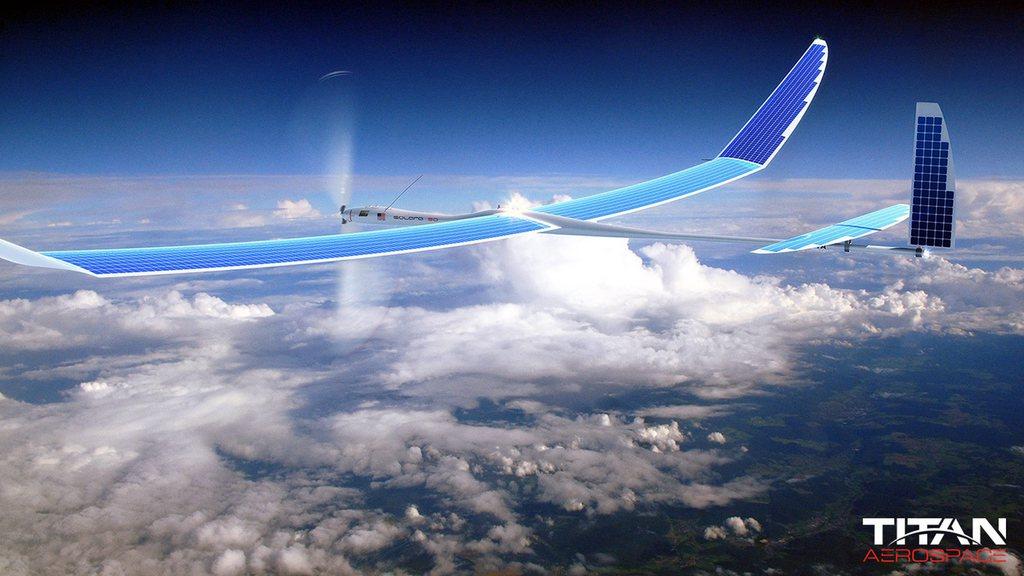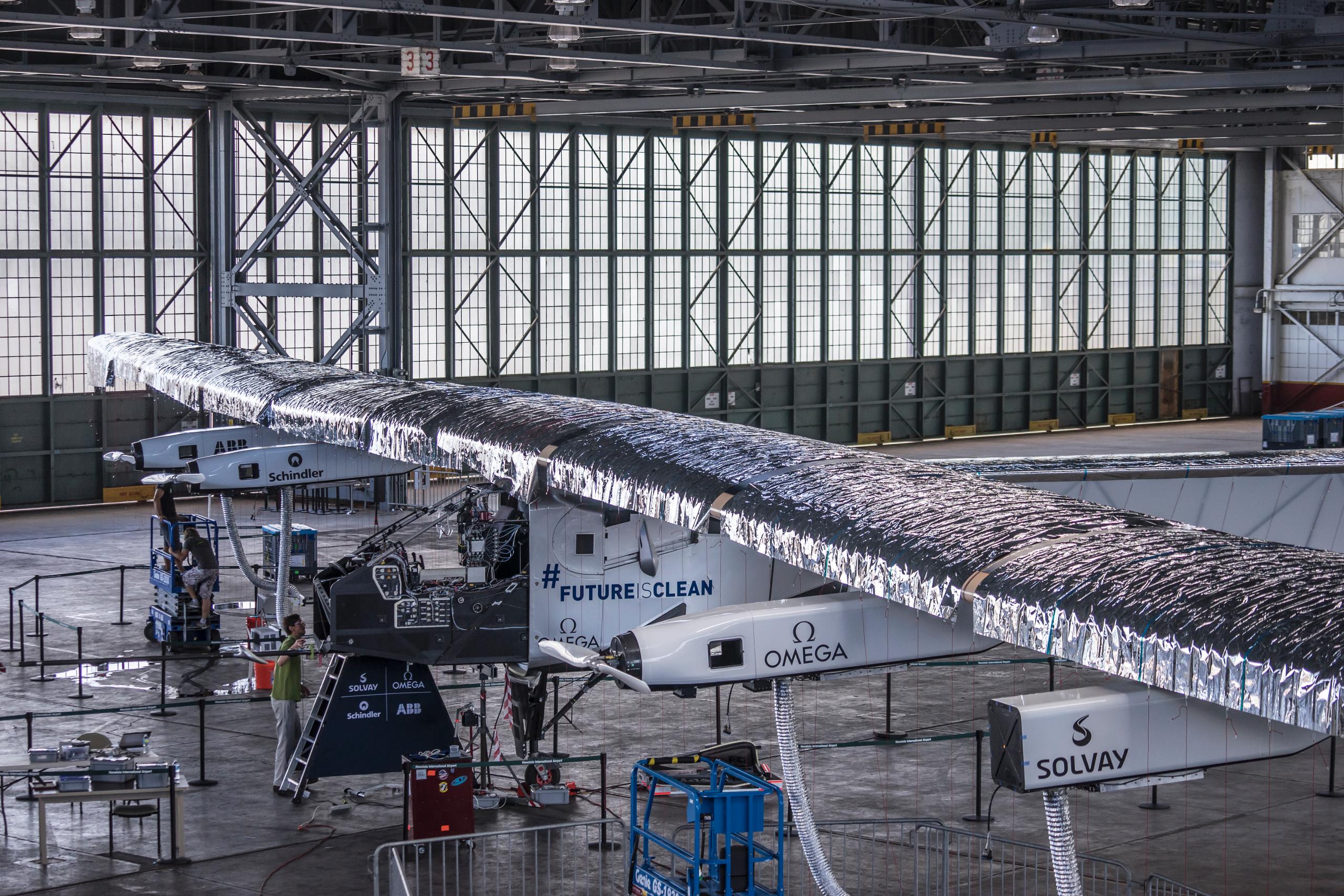Solar Impulse may turn into stratospheric drone

What next for Solar Impulse if the plane completes its round-the-world flight this year? One idea is to develop solar drones to replace satellites, joining Facebook and Google in this experimental field.
Solar ImpulseExternal link pilot André Borschberg touched on his future plans in a recent blog postExternal link, “After Solar Plane, Solar Drones?”: “Think about an aircraft capable of flying at high altitudes for months at a time! And of course, by definition, this would be unmanned. Often referred to as drones, they could replace satellites or complement what they do in terms of observation and communication.”
This is not just a pipe dream. The team of engineers, designers and partners who created the record-breaking solar plane, known as Si2, are carrying out an advanced feasibility study to develop solar drones or so-called high-altitude pseudo-satellites (HAPS).
“It is almost at the pre-design stage,” Borschberg told swissinfo.ch. “We’ll be moving from an exploration project to an industrial project.”
His idea is to build smaller, lighter, more efficient unmanned aircraft than the Si2, with a wingspan of 30-50 metres and a payload of only 50kg [the Si2 has a wingspan of 72m and 250-300kg payload]. Controlled from the ground, he hopes each drone can fly nonstop for up to six months in the calm stratosphere at around 20,000 metres, safely above commercial airliners and thunderstorms. And for each new flight, equipment would be replaced, upgraded and adapted for the needs of the mission.
“It will be much easier for us to scale down and make something lighter than for others who make light models and then try to scale up,” said Borschberg.
The plane and wings will nonetheless have to be redesigned, as in the stratosphere there is hardly any air to use as lift and much more power and energy will be needed to stay aflight.
Monitoring the planet
The 63-year-old pilot, who recently took part in the CO21 United Nations climate talks in Paris with Solar Impulse co-founder Bertrand Piccard, says their focus would be environmental monitoring.
“There is a growing need to observe the Earth from the sky,” he said. “The climate is changing and the patterns are different year after year. It is increasingly important to be able to monitor and react quickly. I’m sure that by observing from the sky we can improve the use of the land and the quality of the agriculture, as well as our knowledge of oceans and forests.”
He said satellites are already doing this, but they are limited, as their orbits are fixed or too high for observational work, and they offer no flexibility.
“It’s going to be tough… solar drones won’t be flying in 12 months from now. But I hope in 3-5 years’ time we have some above our heads,” said the Swiss pilot.
Flying networks
Solar Impulse will not be alone in the field of stratospheric drones, which is still very much in its infancy. Last summer, FacebookExternal link announced it would begin test flights at the end of 2015 for a solar-powered drone, known as Aquila 1, to deliver internet connectivity to remote parts of the world. At the time of writing, there is no confirmation of the test, however.
Facebook engineers say they have designed a boomerang-shaped drone with a 40-metre wingspan weighing around 450kg. Their aim is to build a fleet that can fly at high altitudes for up to three months and use lasers to beam internet signals via the flying network to stations on the ground.
Tech giant Google is also experimenting in the stratosphere with high-altitude balloonsExternal link, as well as drones and satellites. In 2014, it bought Titan AerospacExternal linke to build a solar-powered high-altitude drone to beat its rival. But in May last year it suffered a setback when the unmanned Solara 50 prototype was destroyed in a crash at a New Mexico test site shortly after take-off.
The US military and Airbus Defence and Space have been active for years on unmanned aerial systems for high-altitude surveillance using alternative power sources. Airbus is working on the Zephyr Z8External link, a solar-powered drone using technology similar to that of Solar Impulse, which can fly at altitudes of 21,000m for up to three months. It has a 23-metre wingspan and weighs only 53kg.
Borschberg said he had been in talks with Facebook and Google, which is one of their sponsors: “I know all these people and if we can work together we will. But I think we are in a great position to develop something very interesting from Switzerland, which is very good at developing technologies and ideas and manufacturing high-end value systems and components.”
“Real potential”
According to Fathi DerderExternal link, a centre-right Radical parliamentarian, there is “real potential in Switzerland to be a leader in this field”.
But hurdles remain regarding regulations. Derder recently filed a parliamentary question on the issue, urging the Swiss authorities, in particular the Federal Office of Civil Aviation, to regulate civil air space to ensure a fertile environment for businesses developing drones.
Derder says the media tends to focus heavily on Solar Impulse, while many other interesting related projects – solar, drone and HAPs – exist in Switzerland, which are “more advanced but less visible”.
One of these is SolarStratosExternal link, led by Swiss adventurer Raphaël Domjan, who sailed round the world on the PlanetSolar solar-powered boat in 2010-2012. He is working with private investors, cantons Neuchâtel and Vaud, and the Swiss Centre for Electronics and Microtechnology to develop small solar-powered planes that can fly in the stratosophere.
His team is also looking to develop a network of stratospheric drones to offer communication services in Switzerland. The plane will make its first test flight in 2016.
OpenStratosphere, a young start-up based at the Federal Institute of Technology in Lausanne (EPFL), also hopes to develop a fleet of drones providing ‘trusted regional satellite-like solutions”.
“In the future each nation will operate their own stratospheric drone system in their national airspace. Each nation is going to want to control what services are provided and who is providing them. I don’t think countries will allow Facebook and Google to provide global coverage via drones,” said founder Simon Johnson. External link
He believes the speed of future development will be determined by battery development and the availability of flying permits – where will the authorities allow you to fly.
“But HAPS will do to satellite what TV did to radio,” he declared.
Solar drones, so-called high-altitude pseudo-satellites (HAPs), could do the job of satellites without the dangers and high expense of rocket launches. The cost of building and launching a satellite can run into tens of millions of dollars.
A HAP is a lightweight drone equipped with solar cells, batteries and propeller engines. They are designed to climb to an altitude of around 21 kilometres, above the weather but far below the 200-kilometre altitude of the lowest satellites.
A HAP climbs during the day using power from its solar panels to drive two tiny electric motors. By night it saves battery power by descending gradually, reaching 15 kilometres or so by morning. In principle, a HAP could remain aloft this way for months.
Airbus’s Zephyr 7 holds the world record for drone endurance, flying continuously for two weeks in July 2010.
Solar Impulse will resume its round-the-world solar flight on April 20 from Hawaii, Swiss pilot André Borschberg told the 24heures newspaper on December 22. That is an ideal period with long days and short nights, he explained.
Borschberg said the plane’s batteries had been changed and insulation improved. On July 15, the team suspended the round-the-world journey after the batteries overheated on its trip from Japan to Hawaii.
The aircraft took off on March 9, 2015 from Abu Dhabi, the capital of the United Arab Emirates, then made stops in Oman, Myanmar and China. It then made an unplanned stop for nearly a month in Japan after high winds damaged a wing. It has covered 8,200km. The single-seat solar-plane broke the record for the world’s longest nonstop solo flight – 118 hours.
Borschberg said they would remain flexible over the return route, which could go via either Vancouver, San Francisco, Los Angeles or Phoenix before stopping in New York. From there it may go to Britain, France, Spain or Morocco.
The wings of Solar Impulse 2, which are wider than those of a Boeing 747, are equipped with 17,000 solar cells that power propellers and charge batteries. It weighs slightly more than a family car. The plane runs on stored energy at night. It can fly up to around 9,000m at an average speed of 28 miles per hour.

In compliance with the JTI standards
More: SWI swissinfo.ch certified by the Journalism Trust Initiative













You can find an overview of ongoing debates with our journalists here . Please join us!
If you want to start a conversation about a topic raised in this article or want to report factual errors, email us at english@swissinfo.ch.